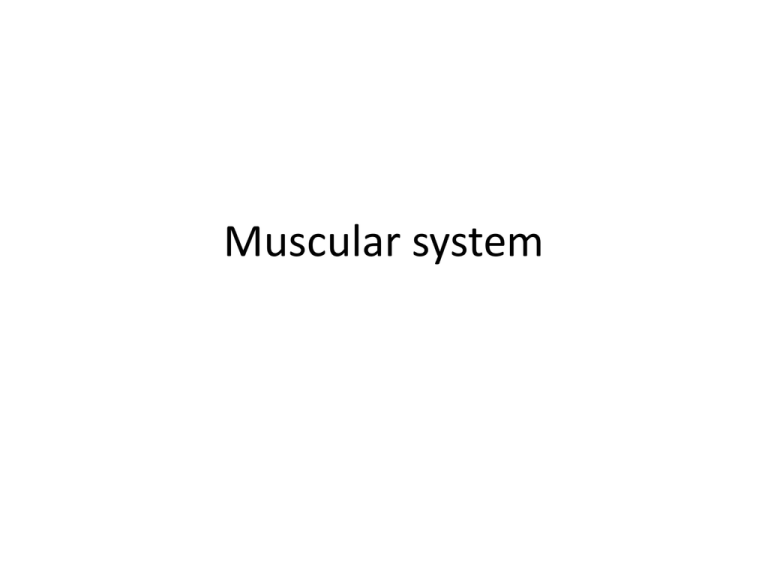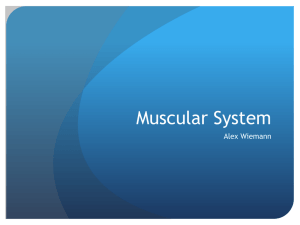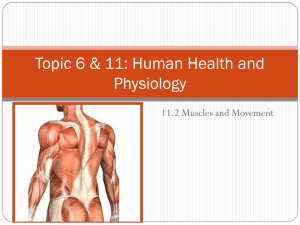Muscular system
advertisement

Muscular system Function • Movement – Contraction of the muscle • Posture – Anti-gravity • Respiration • Heat generation • Communication • Functional characteristics – Structures for contraction – Metabolism • Energy generation – Muscle contraction – Ion concentration gradient maintenance – Heat Physical property • Contractility – Movement of structure – Increased pressure • Vessels and hollow organs • Excitability – Responsiveness to stimuli • Extensibility – Ability to contract after being stretched • Elasticity/recoil – Diaphragm Types of muscles • Skeletal muscles – Locomotion – Facial expression – Posture – Respiration – Voluntary contraction • Exclusive control by nervous system • Smooth muscle – Most widely distributed – Walls of hollow organs – Blood vessels – Some autorhythmic • Spontaneous excitation and contraction • Independent of stimulation • Contraction regulated by various factors • Connective tissues – Attachment • Tendons (extension of fascicles) – Covering • • • • Endomysium (fiber) Perimysium (fascicli) Epimysium (muscle) Muscular fascia – Separates/compartmen talizes muscles • Nerves – Motor neurons • Blood vessels Muscle fibers • Myofibril – Actin (thin) – Myosin (thick) – Actin and myosin are called myofilaments and form sacromeres Sacromeres • Function of myosin head – Interaction with actin • Cross-bridge formation – Contraction of muscle • Bending and recoiling – ATP metabolism Which band/zone corresponds to each figure? Sliding filament model • Actin filament sliding over the myosin – Shortening of sacromere – Responsible for muscle contraction • Shortening of myofibril • Relaxation – Increased sacromere length • Contraction of antagonist muscle • Gravity Show animation! Membrane potential • Axon from motor nerve – Excitation of muscle fiber • Generation of action potential • Differences in electrical charges between inside and outside of the plasma membrane – Differences in amount of Na and K ions – Membrane permeability • K>Na • Membrane permeability – Channels • Voltage-gated • Chemical/ligand-gated Action potential Stimulation Show animation! Na Channels closing K channel opening Na Channels closed K channels open Na Channels open K channel closed • All or nothing principle • Propagation of action potential (animation) – Movement from one spot to the next • Frequency – # AP/time period – Increased AP frequency, increased strength of stimuli • Source of muscular action potential – Signals from nerve fibers • Communicated via the neuromuscular junction Show animation • Clearance of acetylchorine – Rapid • Acetylchorinesterase • 1 presynaptic AP=1postsynaptic AP – Recycled within the axon after metabolism Excitation-Contraction coupling • Conversion of neural signals into physical process of contraction – Generation of muscular action potential • Neural action potential – Contraction • Movement of intracellular Ca in response to muscular action potential • Ca ions – Stored in sacroplasmic reticulum • Modified ER – Released in response to muscular action potential • Transverse/t-tubule General mechanism of contraction • Eight steps – Action potential from the nerve reaches the nerve ending on the muscle fiber – Release of acetylchorine (neurotransmitter) – Opening of multiple acetulchorine-gated channels – Increased flow of Na ions (muscular action potential) – Propagation of action potential across muscle fiber General mechanism of contraction • Eight steps – Depolarization of membrane and release of Ca ions from SR • Traveling of action potential into the inside of the fiber – Attraction of actin and myosin fiber by increased Ca • Sliding of filaments – Removal of Ca into SR • Restoration of filaments Show animation! Cross-bridge movement • Repeated interaction of myosin head and actin myofilament – Sliding of actin along the myosin surface – Repeated attachment and detachment of myosin and actin – Requirement • ATP hydrolysis • Ca ion • Power stroke – Movement of myosin while attached to actin • Recovery stroke – Restoration of myosin head to its original position Show animation Muscle relaxation • Factor that is essential for muscle contraction – Ca • Access to actin active sites – Removal of Ca into SR • Covering of actin active site with troponin-tropomyosin complex – Energy-dependent process • Active Ca pumpus • Restoration of membrane potential – Na-K pumps








